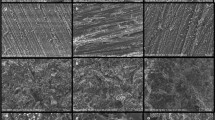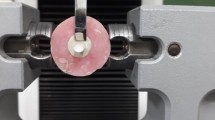Abstract
The high cost of CAD/CAM systems and materials is a severe economic burden. Therefore, repair of CAD/CAM PMMA, selecting appropriate repair materials, and surface modifications are clinically important. This study aims to evaluate the shear bond strength of PMMA repair materials after various surface treatments on CAD/CAM PMMA denture base material. For this purpose, a total of 480 CAD/CAM PMMA denture base test specimens were manufactured. Then all test specimens were divided into 6 groups, and different surface treatments were applied. Group A: sandblasting, Group B: 4% hydro fluoric acid, Group C: tungsten carbide bur, Group D: dichloromethane + methyl methacrylate mixture, Group E: dichloromethane and methyl methacrylate, Group F: no surface treatment. Each group is then divided into 4 different subcategories; repair processes were performed using; heat-cured acrylic resin (n:20), auto-polymerized acrylic resin (n:20), gingiva composite (n:20), and CAD/CAM PMMA tooth material (n:20). After repairs, thermal aging was applied to half of the test specimens in each subcategory. The shear bond strength value was measured with a universal test device. Sandblasting group showed the highest surface roughness value in all test specimens (p < 0.001). Heat-cured acrylic resin with sandblasting exhibited the highest bond strength, while the untreated gingiva composite resin exhibited the lowest value. Thermal aging decreased bond strength in all repair materials (p < 0.001). Among the surface treatment groups, sandblasting with Al2O3 particles exhibited the highest surface roughness value and repair bond strength. The application of organic solvents to the surface increased the surface roughness and repair bond strength. Applying dichloromethane and methyl methacrylate monomer separately is more effective than applying it as a mixture. The ideal bonding among repair materials was obtained with heat-cured acrylic resin.






Similar content being viewed by others
Data availability
All data on the repair bond strength of milled PMMA denture base supporting the findings of this study are included in this paper and Supplementary Information files.
References
Yilmaz B, Azak AN, Alp G, Ekşi H. Use of CAD-CAM technology for the fabrication of complete dentures: an alternative technique. J Prosthet Dent. 2017;118(2):140–3.
Kalberer N, Mehl A, Schimmel M, Müller F, Srinivasan M. CAD-CAM milled versus rapidly prototyped (3D-printed) complete dentures: an in vitro evaluation of trueness. J Prosthet Dent. 2019;121(4):637–43.
de Mendonça AF, Furtado de Mendonça M, White GS, Sara G, Littlefair D (2016) Total CAD/CAM supported method for manufacturing removable complete dentures. Case reports in dentistry 2016.
Janeva NM, Kovacevska G, Elencevski S, Panchevska S, Mijoska A, Lazarevska B. Advantages of CAD/CAM versus conventional complete dentures-a review. Open Access Maced J Med Sci. 2018;6(8):1498.
Unkovskiy A, Wahl E, Zander AT, Huettig F, Spintzyk S. Intraoral scanning to fabricate complete dentures with functional borders: a proof-of-concept case report. BMC Oral Health. 2019;19(1):1–7.
Li Y, Han W, Cao J, Iv Y, Zhang Y, Han Y, Liu H (2018) Design of complete dentures by adopting CAD developed for fixed prostheses. J Prosthod 27(2): 212–219.
Srinivasan M, Kalberer N, Naharro M, Marchand L, Lee H, Müller F. CAD-CAM milled dentures: the Geneva protocols for digital dentures. J Prosthet Dent. 2020;123(1):27–37.
Han W, Li Y, Zhang Y, Zhang Y, Hu P, Liu H, Shen Y. Design and fabrication of complete dentures using CAD/CAM technology. Medicine. 2017;96(1):e5435
Schweiger J, Güth JF, Edelhoff D, Stumbaum J. Virtual evaluation for CAD-CAM-fabricated complete dentures. J Prosthet Dent. 2017;117(1):28–33.
Infante L, Yilmaz B, McGlumphy E, Finger I. Fabricating complete dentures with CAD/CAM technology. J Prosthet Dent. 2014;111(5):351–5.
Perea-Lowery L, Minja IK, Lassila L, Ramakrishnaiah R, Vallittu PK. Assessment of CAD-CAM polymers for digitally fabricated complete dentures. J Prosthet Dent. 2021;125(1):175–81.
Barbosa DB, Barão VAR, Monteiro DR, Compagnoni MA, Marra J. Bond strength of denture teeth to acrylic resin: effect of thermocycling and polymerisation methods. Gerodontology. 2008;25(4):237–44.
Ayman AD. The residual monomer content and mechanical properties of CAD\CAM resins used in the fabrication of complete dentures as compared to heat cured resins. Electron Physician. 2017;9(7):4766.
Steinmassl PA, Wiedemair V, Huck C, Klaunzer F, Steinmassl O, Grunert I, Dumfahrt H. Do CAD/CAM dentures really release less monomer than conventional dentures? Clin Oral Invest. 2017;21(5):1697–705.
Barbosa DB, Monteiro DR, Barão VAR, Pero AC, Compagnoni MA. Effect of monomer treatment and polymerisation methods on the bond strength of resin teeth to denture base material. Gerodontology. 2009;26(3):225–31.
Srinivasan M, Gjengedal H, Cattani-Lorente M, Moussa M, Durual S, Schimmel M, Müller F. CAD/CAM milled complete removable dental prostheses: An in vitro evaluation of biocompatibility, mechanical properties, and surface roughness. Dental materials journal. 2018;37(4):526–33.
Murat S, Alp G, Alatalı C, Uzun M. In Vitro evaluation of adhesion of candida albicans on CAD/CAM PMMA-based polymers. J Prosthodont. 2019;28(2):e873–9.
Steinmassl PA, Klaunzer F, Steinmassl O, Dumfahrt H, Grunert I. Evaluation of currently available CAD/CAM denture systems. Int J Prosthodont. 2017;30(2):116–22.
Steinmassl O, Dumfahrt H, Grunert I, Steinmassl PA. CAD/CAM produces dentures with improved fit. Clin Oral Invest. 2018;22(8):2829–35.
Dayan C, Guven MC, Gencel B, Bural C. A comparison of the color stability of conventional and CAD/CAM polymethyl methacrylate denture base materials. Acta Stomatol Croat. 2019;53(2):158.
Park BW, Kim NJ, Lee J, Lee HH. Technique for fabricating individualized dentures with a gingiva-shade composite resin. J Prosthet Dent. 2016;115(5):547–50.
Bedrossian EA, Chung KH. Effect of layering gingiva-shade composite resin on the strength of denture base polymers. J Prosthet Dent. 2019;122(2):153-e1.
Mahadevan V, Krishnan M, Krishnan CS, Azhagarasan NS, Sampathkumar J, Ramasubramanian H. Influence of surface modifications of acrylic resin teeth on shear bond strength with denture base resin-an invitro study. J Clin Diagnos Res JCDR. 2015;9(9):16.
Venkat R, Gopichander N, Vasantakumar M. Comprehensive analysis of repair/reinforcement materials for polymethyl methacrylate denture bases: mechanical and dimensional stability characteristics. J Indian Prosth Soc. 2013;13(4):439–49.
Wiegand A, Stucki L, Hoffmann R, Attin T, Stawarczyk B. Repairability of CAD/CAM high-density PMMA-and composite-based polymers. Clin Oral Invest. 2015;19(8):2007–13.
Jeong KW, Kim SH. Influence of surface treatments and repair materials on the shear bond strength of CAD/CAM provisional restorations. J Adv Prosthod. 2019;11(2):95–104.
Minami H, Suzuki S, Minesaki Y, Kurashige H, Tanaka T. In vitro evaluation of the influence of repairing condition of denture base resin on the bonding of autopolymerizing resins. J Prosthet Dent. 2004;91(2):164–70.
Al-Dwairi ZN, Tahboub KY, Baba NZ, Goodacre CJ, Özcan M. A comparison of the surface properties of CAD/CAM and conventional polymethylmethacrylate (PMMA). J Prosthodont. 2019;28(4):452–7.
Pereira SMB, Castilho AA, Salazar-Marocho SM, Oliveira KMC, Váquez VZC, Bottino MA (2007) Thermocycling effect on microhardness of laboratory composite resins. Braz J Oral Sci: 1372–1375
Özcan M, Alander P, Vallittu PK, Huysmans MC, Kalk W. Effect of three surface conditioning methods to improve bond strength of particulate filler resin composites. J Mater Sci Mater Med. 2005;16(1):21–7.
Klaiber D, Spintzyk S, Geis-Gerstorfer J, Klink A, Unkovskiy A, Huettig F. Bonding behavior of conventional PMMA towards industrial CAD/CAM PMMA and artificial resin teeth for complete denture manufacturing in a digital workflow. Materials. 2021;14(14):3822.
Akin H, Kirmali O, Tugut F, Coskun ME. Effects of different surface treatments on the bond strength of acrylic denture teeth to polymethylmethacrylate denture base material. Photomed Laser Surg. 2014;32(9):512–6.
Sarac YS, Sarac D, Kulunk T, Kulunk S. The effect of chemical surface treatments of different denture base resins on the shear Bond Strength of Denture Teeth to Denture Base Resinsrepair. J Prosthet Dent. 2005;94(3):259–66.
Dandiwal N, Kumar S, Jain S, Aggarwal R, Singla N, Reddy NK. Evaluation of shear bond strength of three different acrylic resin and artificial denture teeth with and without monomer application. J Contemp Dent Pract. 2019;20(1):94–100.
Shimizu H, Takahashi Y. Review of adhesive techniques used in removable prosthodontic practice. J Oral Sci. 2012;54(3):205–11.
Takahashi Y, Chai J, Takahashi T, Habu T. Bond strength of denture teeth to denture base resins. Int J Prosthodont. 2000;13(1):59–65.
Meloto CB, Rodrigues-Garcia R, Canales GT, Rizzatti-Barbosa CM. Effect of surface treatments on the bond strength of different resin teeth to complete denture base material. Acta Odontol Latinoam. 2013;26(1):37–42.
Rupp NW, Bowen RL, Paffenbarger GC. Bonding cold-curing denture base acrylic resin to acrylic resin teeth. J Am Dent Assoc. 1971;83(3):601–6.
Choi JJE, Uy CE, Plaksina P, Ramani RS, Ganjigatti R, Waddell JN. Bond strength of denture teeth to heat-cured, CAD/CAM and 3D printed denture acrylics. J Prosthodont. 2020;29(5):415–21.
Han SY, Moon YH, Lee J. Shear bond strength between CAD/CAM denture base resin and denture artificial teeth when bonded with resin cement. J Adv Prosthod. 2020;12(5):251.
Chung KH, Chung CY, Chung CY, Chan DCN. Effect of pre-processing surface treatments of acrylic teeth on bonding to the denture base. J Oral Rehab. 2008;35(4):268–75.
Shimizu H, Kawaguchi T, Yoshida K, Tsue F, Takahashi Y. Effect of surface preparation on the failure load of a highly filled composite resin bonded to a denture base resin. J Prosthod Implant Esth Reconstruct Den. 2009;18(8):684–7.
Papazoglou E, Vasilas AI. Shear bond strengths for composite and autopolymerized acrylic resins bonded to acrylic resin denture teeth. J Prosthet Dent. 1999;82(5):573–8.
Stawarczyk B, Basler T, Ender A, Roos M, Özcan M, Hämmerle C. Effect of surface conditioning with airborne-particle abrasion on the tensile strength of polymeric CAD/CAM crowns luted with self-adhesive and conventional resin cements. J Prosthet Dent. 2012;107(2):94–101.
Floyd CJ, Dickens SH. Network structure of Bis-GMA-and UDMA-based resin systems. Dent Mater. 2006;22(12):1143–11.
Acknowledgements
This work was supported by the Unit of Scientific Research Projects Fund of Gazi University, Ankara, Turkey (Grant number: 03/2020-08). Statistician Neslihan Gökmen contributed to the analysis of statistical data in this study.
Author information
Authors and Affiliations
Corresponding author
Ethics declarations
Conflict of interest
The authors declare that they have no competing interests.
Additional information
Publisher's Note
Springer Nature remains neutral with regard to jurisdictional claims in published maps and institutional affiliations.
Rights and permissions
Springer Nature or its licensor (e.g. a society or other partner) holds exclusive rights to this article under a publishing agreement with the author(s) or other rightsholder(s); author self-archiving of the accepted manuscript version of this article is solely governed by the terms of such publishing agreement and applicable law.
About this article
Cite this article
Erbulak, Z., Ergun, G. The effects of different surface treatments applied to milled PMMA denture base material on repair bond strength. Odontology 111, 953–970 (2023). https://doi.org/10.1007/s10266-023-00806-z
Received:
Accepted:
Published:
Issue Date:
DOI: https://doi.org/10.1007/s10266-023-00806-z




